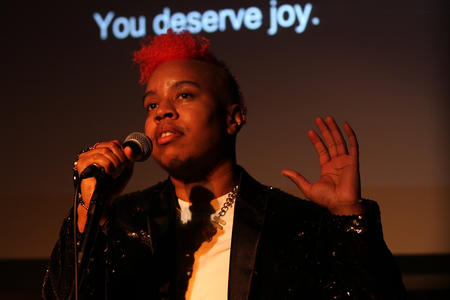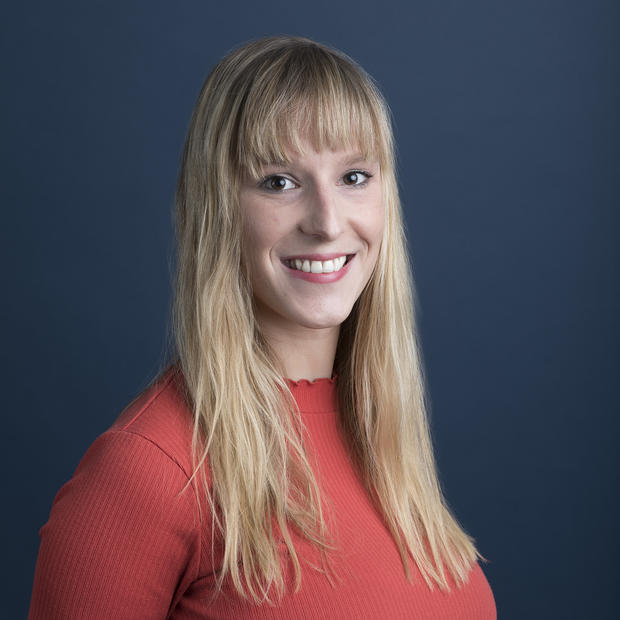A hurried call back from his West Seattle apartment confirmed his hunch: Mase and Washington, D.C.-based collaborator Lady Dane Figueroa Edidi would receive a coveted $100,000 Creative Capital award for the duo’s new project. The “performative documentary” is a continuation of their Black Trans Prayer Book project, a collection of poems, prayers, spells and meditations affirming the spiritual realities of Black trans people.
Announced today, the Creative Capital grants are awarded yearly by the New York nonprofit of the same name.
Edidi and Mase are not the only team with Pacific Northwest roots receiving the prestigious designation this year. Vashon Island-based artists and activists Beka Economopoulos and Jason Jones of The Natural History Museum also received a $100,000 grant. Along with collaborators from across the country, they plan to put natural history “on trial” in an interactive exhibit, The Supreme Court of Red Natural History, at the Carnegie Museum of Natural History in Pittsburgh.
This year marks the second consecutive in which two of the Creative Capital grants — selected from thousands of applications that come in from every state — have gone to Pacific Northwest artists. Last year, local filmmaker Wes Hurley received a Creative Capital grant to turn Little Potato, his award-winning short film about growing up gay in Russia and fleeing to the U.S., into a feature-length film. Shontina Vernon, the (then Seattle-based) actor, theater maker and filmmaker, received the grant in 2019 as well, for Forging Ahead, a multidisciplinary stage show exploring youth incarceration and its impacts on identity.
Suzy Delvalle, Creative Capital’s president and executive director, noted the recent “uptick” in Pacific Northwest winners. “It’s skewed in that direction the last few years,” she says.
This year’s local winners also reflect a wider trend of artist collectives and collaborations across cities and regions. “More and more artists are working more collaboratively, and not just within their own communities,” Delvalle says. The idea is “bringing this other perspective, where there is shared learning and shared creative expression as a result.”
That’s very much the case for The Natural History Museum. Founders Economopoulos and Jones, along with five people from across the U.S., form Not An Alternative, the art and activism collective responsible for the long-term project.
The Natural History Museum rose to somewhat “viral” fame in 2014, when Not An Alternative teamed up with 150 scientists to urge museums to cut ties to fossil fuel interests. And it was not (only) by staging protests, Not An Alternative co-founder Economopoulos explains.
One of the Natural History Museum's earlier projects at the American Alliance of Museums Annual Convention, in Atlanta, 2015. Their twist on the classic diorama depicted "the David H. Koch Dinosaur Wing at the American Museum of Natural History several hundred years into a dystopian future," and was meant to persuade museums to divest from fossil fuels. (The Natural History Museum)
Members of Not An Alternative and originators of 'The Natural History Museum' project, from left: Julian Brave Noisecat (Secwepemc/St'at'imc), Karina Yager (Quechua), Steve Lyons, Beka Economopoulos, Cassandra Begay (Diné), Jason Jones. Not pictured: Judith LeBlanc (Caddo). (Natural History Museum).
“Rather than shaking our fist from the outside,” says Economopoulos, “we created a new museum to get inside this and try to change it from within.” She calls it a “Trojan horse strategy.” As The Museum of Natural History — a museum lacking permanent location, big-time donors or even four walls besides those of their van — they attended any museum conference and convention they could invite themselves to, and installed pop-up exhibits featuring dioramas with polar bears and Koch Industries oil pipelines. The group managed to persuade multiple museums, including The Field Museum in Chicago (one of the largest natural history museums in the world), and The California Academy of Sciences in San Francisco to divest from fossil fuels.
More recently, the group collaborated with Lummi tribal members to bring a 3,000-pound totem pole to the Florida Museum of Natural History to help raise awareness of the environmental dangers threatening Pacific Northwest whales.
For their newest project, The Supreme Court of Red Natural History, they’ll work with Indigenous leaders, scientists and natural history scholars to create a legal simulacrum. The accused: natural history and its colonial legacy. A Dutch artist will build a replica of the U.S. Supreme Court chambers, which will be used as an actual people’s tribunal during a multiday event. The artwork is mostly intangible, straddling the line between art, activism and institutional critique. The end goal: inaugurate a new alliance of Indigenous leaders and natural scientists who will champion a “non-extractive” relationship to land.
“There are few spaces for financial and capacity building for projects that don’t fit neatly in a box of fine art, or neatly in a box of activism,” Economopoulos says. “Creative Capital is one of those few spaces that really supports this nexus of art and activism.”
Mase, of the Black Trans Prayer Book, is grateful for the Creative Capital boost as well, especially given the challenges of fundraising while Black and trans. The three years fundraising for the actual paper book, a self-published anthology set to be released Feb. 1, was making “a lot of water from stone,” Mase says.
“As two Black trans people, to say, ‘We want to create this thing that is about the healing needs and spiritual needs of Black trans people’ meant that it also wasn't sexy to funders,” Mase says. At first, they feared the same would be true for their documentary, which will feature some of the book’s contributors. Given that so many of them are musicians, writers, poets, dancers, Mase and Edidi hope to incorporate the contributors’ art practices and the way these intersect with spiritual practices into the documentary.
With the Creative Capital grant in hand, the duo plans to start filming this summer. “We’re really excited to be able to move forward in the work that we know our community deserves,” Mase says.
The Creative Capital grant is considered one of the most prestigious art grants in the country. The nonprofit likes to say its grant program, born in the late 1990s, is “venture capital” for the arts: in addition to $50,000 in direct project funding, grantees also get networking opportunities, artists retreats, expert consulting and legal and other counsel, which Creative Capital says is worth another $50,000. Grantees say it’s the latter that often proves the most valuable in the long term.
“First you see that it’s $50,000 and you’re like, wow, amazing,” says Ben Beres, who won the 2008 award with artist collective SuttonBeresCuller for their Mini Mart City Park project, which should be completed this summer in the Georgetown neighborhood of Seattle. “But what you don’t realize is it’s all the other things that the grant gives you.”
Beres still remembers the time when, during his first Creative Capital dinner in New York, a “Laura” who was making a documentary in Yemen introduced herself. It turned out to be famed documentary filmmaker Laura Poitras.
Being surrounded with artists and curators of that caliber, from all over the world, is a networking opportunity that has lead SuttonBeresCuller to projects in Minneapolis, Toronto, MAss MOCA, China and Serbia — and it’s also a confidence boost, Beres says.
Creative Capital helps you dream big, awardees say. The program’s mentors show you how to advocate for yourself, reinforce your worth as an artist and think of yourself more like a business.
Ahamefule J. Oluo, who is currently bringing his Creative Capital project Susan to stages in New York and Seattle, said the experience taught him how to negotiate better. Thanks to the program’s mentors, SuttonBeresCuller considered what it would be like to make their Mini Mart project permanent (which it will be, once finished). And Mase and Edidi shifted from “maybe we’ll put our film up on YouTube” to “what if Netflix or Hulu would want to screen it?”
Beres also thinks the awards are a way to represent the Pacific Northwest on that other coast. In fact, data from Creative Capital shows that while most grant winners over the past 20 years hail from California or New York (home to art world capitals New York and Los Angeles), Washington state is tied with Illinois for third place for producing winners of the award, 26 in total. That list includes artists like Deborah Faye Lawrence, Susan Robb, Degenerate Art Ensemble, Lead Pencil Studio, Christian E. Vargas and sometime-Seattleite Paul Rucker.
“If you just look at all those names, and all those people, you start to see the quality … you start to see who they’re dealing with in the Northwest,” Beres says. “There’s a bunch of badasses up here.”
Get the latest in local arts and culture
This weekly newsletter brings arts news and cultural events straight to your inbox.










